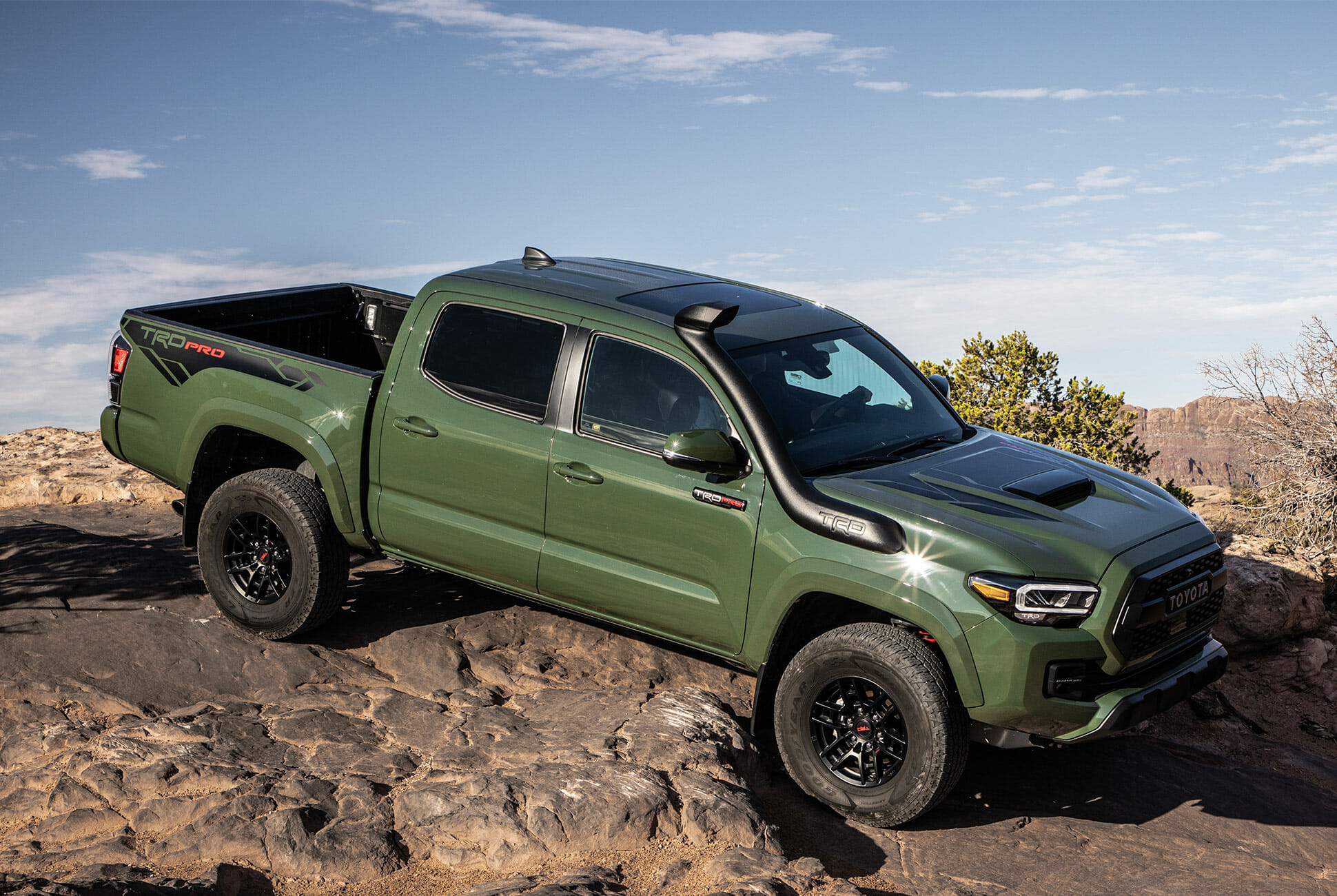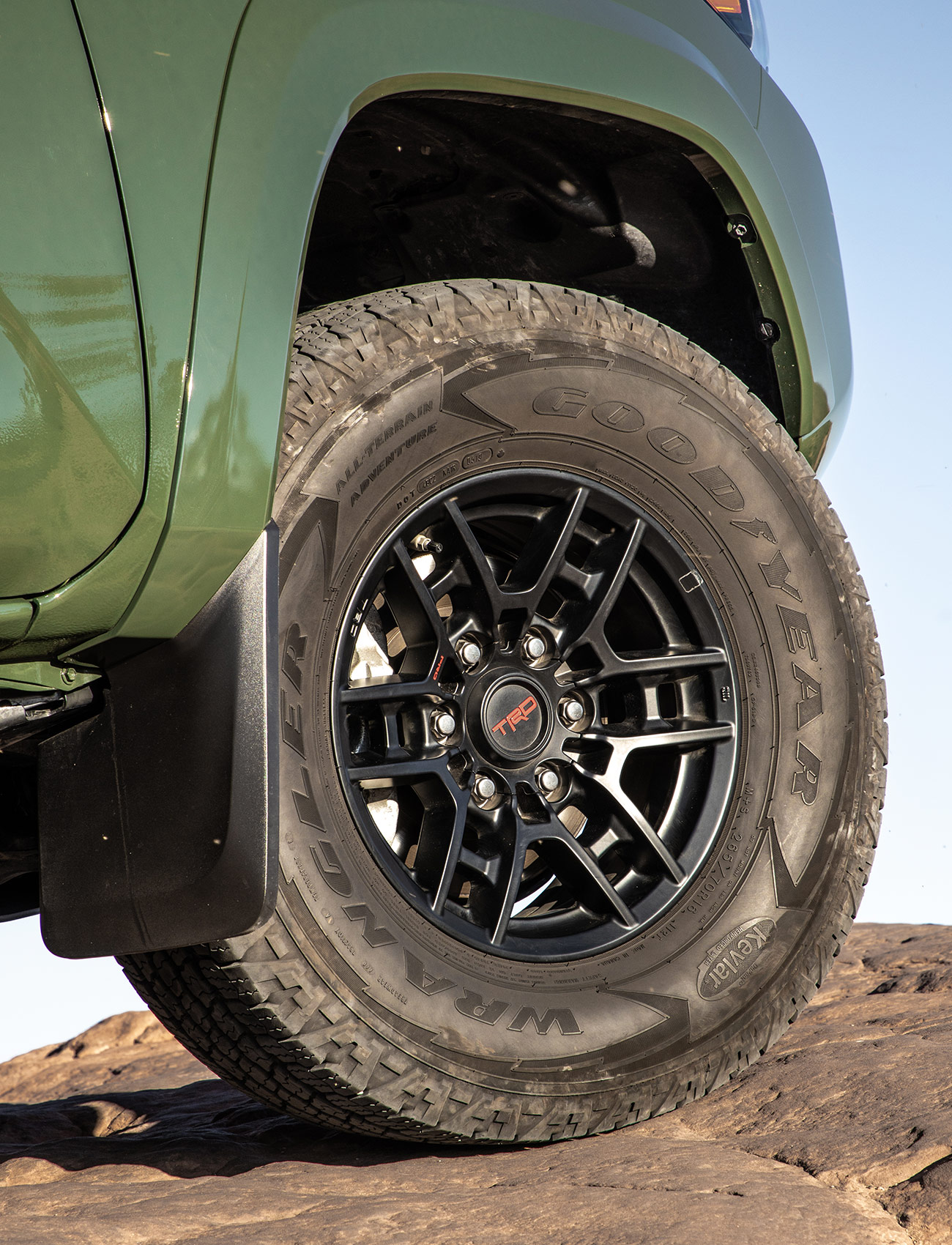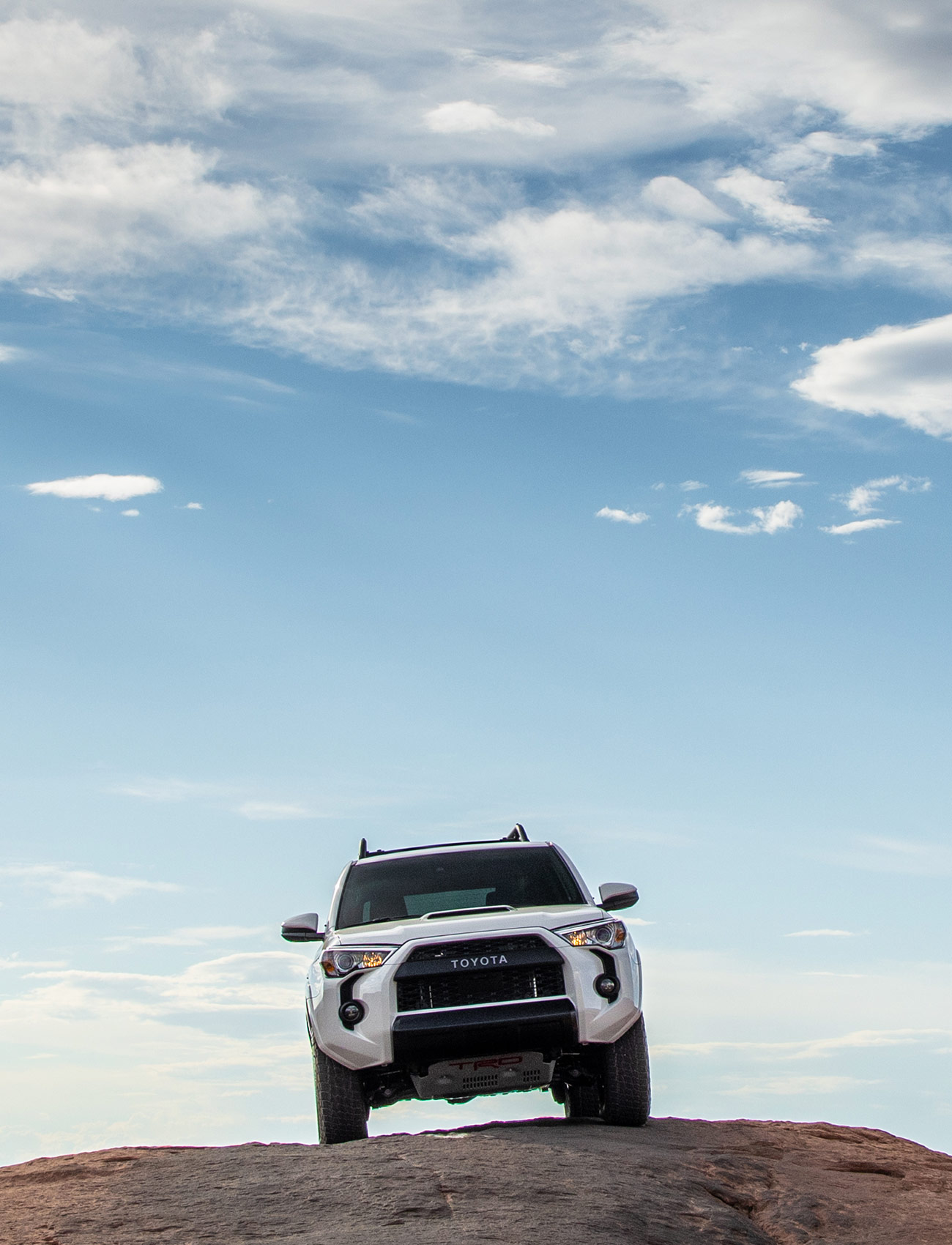Overlanding and off-roading are not synonymous. The ballistic-missile ascent of the former term into the modern vernacular has left hardcore trail enthusiasts wincing at its ubiquitous misuse by the masses who simply guide their tires from asphalt to gravel and bop around a little. Overlanding and off-roading are about intent, not actions. When a remote journey itself, not the destination, is the purpose of the trip, you’re overlanding. And when you attempt to conquer mighty earthly obstacles, you’re off-roading.
Informed denizens of the four-by-four community are quick to note that not all 4x4s are suitable for both endeavors. Toyota, however, builds two steeds capable of dominating both domains: the Tacoma TRD Pro and the 4Runner TRD Pro. Both have been treated to a light refresh for the 2020 model year. To sample them in their rightful element, we (along with a gaggle of other journalists) took them on an excursion across the American West, from the blistering Utah deserts to the lush Colorado mountains.
The Good: Reliability and durability are two defining attributes across Toyota’s entire lineup. The Tacoma and 4Runner have always exhibited both qualities in such spades that when it came time to reimagine them for 2020, it was hard to fix what’s not broken. The workhouse powertrains remain unchanged, as does the beefy exterior styling. So what is new? On the 4Runner, a TRD-branded cat-back exhaust system has been added. A redesigned instrument panel brings a touch of modernity to the spartan cabin, as does a honking 8.0-inch touchscreen multimedia display that now features Apple Car Play, Android Auto and Amazon Alexa capabilities.
The same 8.0-inch screen and connectivity addition in the Taco breathes new life into the low-tech brute that launched in 2005 and has since gone largely unchanged, save for a 2016 update. The Tacoma also receives an eye lift in the form of new LED and Daytime Running Light headlights and the inclusion of LED foglights. Lastly, the helpful and effective Panoramic View Monitor (PVM) and Multi-Terrain Monitor (MTM) features both come standard on the new Tacos.
Who They’re For: No-frills adventure-seekers who’ll spend a considerable chunk of wheel time on unpaved ground. And people who will it drive often, on their way to the 250,000-mile club. Accordingly, the economically-minded will appreciate the low-maintenance requirements, long life expectancy and impressive resale value these vehicles offer.

Watch Out For: While the Tacoma and 4Runner are big strides forward, especially in the cabin, there’s still room for improvement in the creature-comfort department. The 4Runner remains sparse inside compared to rival SUVs. Despite being a beloved bombproof legend, the Tacoma has long suffered from a seat design that offers no real comfortable way for gangly-limbed occupants to comfortably rest. (The flat raised floor does afford better ground clearance off-road.) Toyota’s tried to address seating woes by bestowing the Taco with new 10-way power-adjustable seats; they help a smidgen but don’t rectify the issue. Lastly, there’s no telescoping wheel in the Taco, which is a true head-scratcher in this day and age.
Alternatives: Buyers of the Tacoma would likely cross-shop the Ford Ranger in Lariat trim (starting at $33,350) and the Chevrolet Colorado ZR2 (beginning at $42,000), while 4Runner prospectives would eye the Jeep Grand Cherokee (from $32,045) and perhaps the new Ford Explorer (from $36,675), though the Blue Oval wouldn’t stack up as well off-road.
Review: It was a withering 103 degrees when we hit the trailhead of Hell’s Revenge, a 5.5-mile off-road route nestled in the outskirts of Moab, Utah. The name doesn’t obfuscate what you’re about to undertake: The sinewy route is tricky and treacherous, riddled with boulders the size of dumpsters, cross-axle obstacles and steep hills that frequently leave you staring at the pristine blue sky.

As we queued up, seriously-kitted-out Jeep Wranglers streamed past — lifted to the sun, affixed tall jacks glistening. Our TRD Pros were bone-stock — a condition our fearless and affable trail guide Kurt Williams of Cruiser Outfitters claimed he’d never run here despite his 100-plus passes, though he had the utmost confidence we would emerge unscathed. (Even Williams’ lead vehicle, his own 2004 Land Cruiser, was modded with rail and rocker guards, a sizable lift, aftermarket shoes and custom bumpers, though he left the drivetrain untouched.)
The mantra of off-roading is “as slow as possible, as fast as necessary.” So we inched our way forward in a 4Runner. On this harsh, undulating terrain, the body-on-frame SUV is at its best. The Nitto Terra Grappler tires — slightly deflated for the affair — offer impressive grip, and the 2.5-inch Fox internal bypass shocks that bestow an extra inch of lift over other 4Runner models will keep the sweat from beading on your brow as you crawl over everything in your path. The aging 4.0-liter, naturally-aspirated V6 offering 270 horsepower and 278 pound-feet of yank are more than sufficient, and you won’t use more than two of the automatic transmission’s five gears available while scrambling around off-road
The Multi-Terrain Select system lets you select from Mud and Sand, Rock and Dirt, Loose Rock, and Mogul and Rock modes. Each changes the brake-based torque vectoring to eliminate wheel spin, along with adjusting the throttle’s responsiveness. Coupled with an electronically-locking rear differential, you’re unstoppable. Ascending stretches where the gradient exceeded 25 degrees was a breeze, provided you’d locked the diff. (Fail to do so, and the 4Runner will shudder and skitter in place.)
The five-level Crawl Control system is a neat parlor trick that’ll help keep everything tidy by taking throttle and braking control out of your hands and allowing you to focus on steering and your line, but it’s more fun to modulate the pedals on your own. Loose steering and long accelerator pedal travel provide a nice buffer for you to find exactly the right amount of input, thus allowing you to keep trucking.
The short wheelbase of the 4Runner meant no trailer hitches kissed the umber Utah rocks. The lengthier Tacoma Double Cab, however, did make contact at a few points, albeit briefly — and no real damage was done. On Hell’s Revenge, the Taco shone bright, its surefooted prowess demonstrating why it’s such an icon in these conditions. It also enjoys the same lifted suspension and Fox shocks as the $Runner, and the 3.5-liter V6 mill good for 278 horsepower and 265 lb-ft of twist keeps you clambering forth with ease. Goodyear Wrangler All-Terrain Adventure 16-inch tires impart impeccable grip, even in slippery spots.

The PVM and MTM systems, which show the area around the vehicle via screen, are a kind feature that comes in handy when you’re climbing and the hood — sloped down a few degrees for better sighting — rises above the head of your trail guide. You can use the cameras to make sure you’re aimed the right way, and that your forward path is free of large obstacles. The downside is the pixelated resolution of the screen; it’s not crisp enough to see individual rocks in your blind spots, something engineers acknowledged they’d continue to tinker with. Still, you’re better off with the systems than without.
En route to Ouray, Colorado, we did some light pseudo-overlanding over the La Sal Mountains, where both the Tacoma and the 4Runner lapped up the gravel and dirt trails some 10,000 feet above sea level. Bashing around the loose surfaces was a hoot, but it was here that the transmissions started to show their age. The Taco suffers from incessant gear-hunting, seemingly never content with its own selection. It’s constantly rowing through the six-speed auto (this problem wouldn’t exist in the optional manual version); just when it settles, you’ll inevitably need more power, forcing a downshift — and the whole process starts anew. Engineers have recalibrated the transmission recently, tweaking shift points for improved fuel efficiency, but a little more time spent here may benefit drive quality. The 4Runner’s gearbox is better, but hints of the same issue show under harder pushes.
Verdict: The final stretch of the trip was on the highways of Colorado. If you’re looking for a sedate and plush mile-logger, the Taco and 4Runner may disappoint. The same attributes that make them impeccable off-road leave something to be desired when it comes to pavement manners; there’s a bit of brake dive on both vehicles, and the loose steering becomes unwelcome at a highway clip. But the people who understand the intent of these immutable machines — the overlanding and off-road zealots seeking uncharted exploration and adventure — certainly won’t be disappointed by the 2020 4Runner and Tacoma TRD Pros in the least.
2020 Toyota 4Runner and Tacoma: Key Specs
Powertrain: Tacoma – 3.5-liter V6, six-speed automatic or six-speed manual, four-wheel-drive; 4Runner – 4.0-liter V6, five-speed automatic, four-wheel-drive
Horsepower: Tacoma – 278; 4Runner – 270
Torque: Tacoma – 265 lb-ft; 4Runner – 278 lb-ft
0-60 MPH: Tacoma – 7.3 seconds; 4Runner – 7.5 seconds
Fuel Economy: Tacoma – 18 mpg city, 22 mph highway; 4Runner – 17 mpg city, 20 mpg highway (2019 model)
Toyota hosted us and provided these products for review.

Hot takes and in-depth reviews on noteworthy, relevant and interesting products. Read the Story

